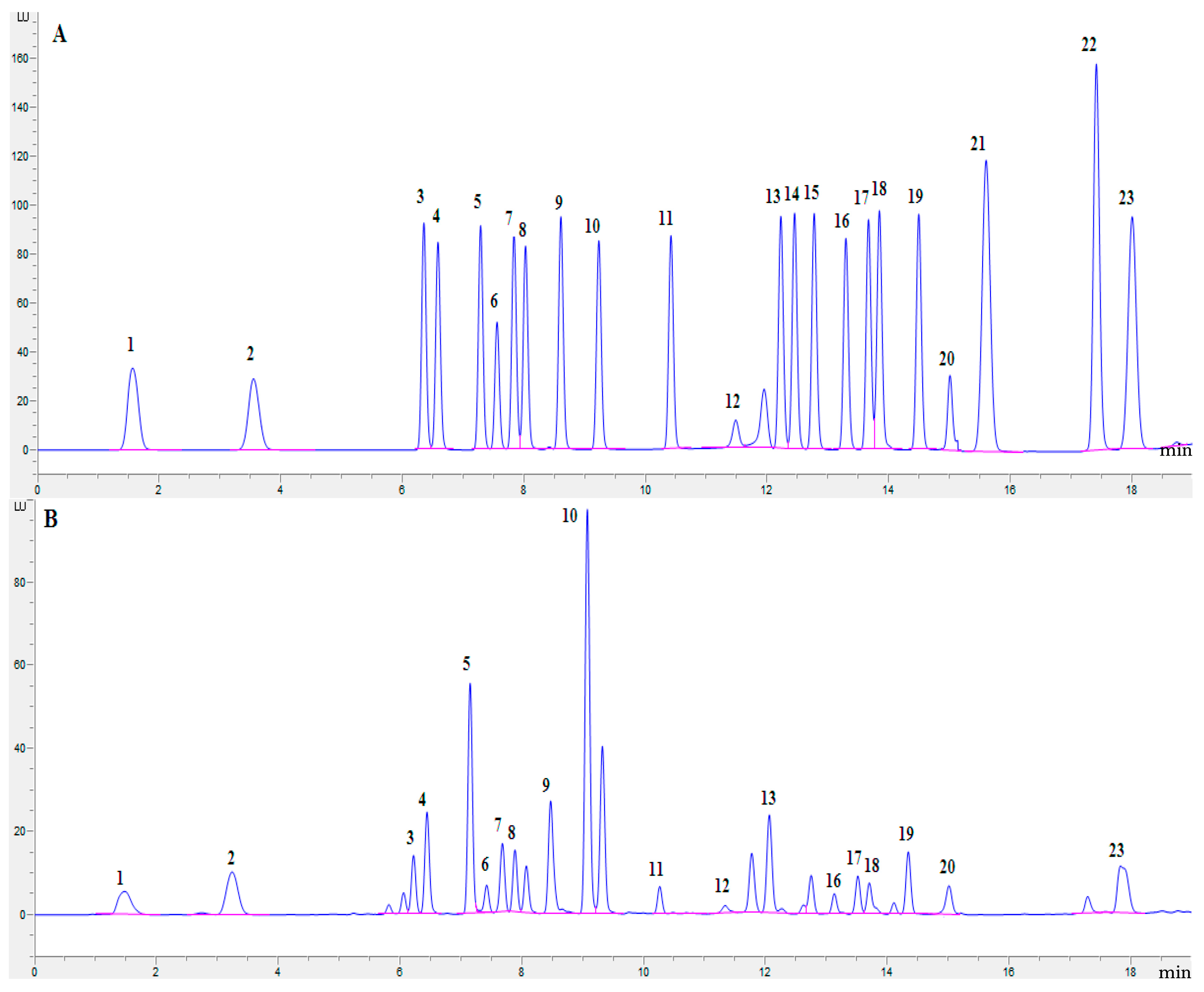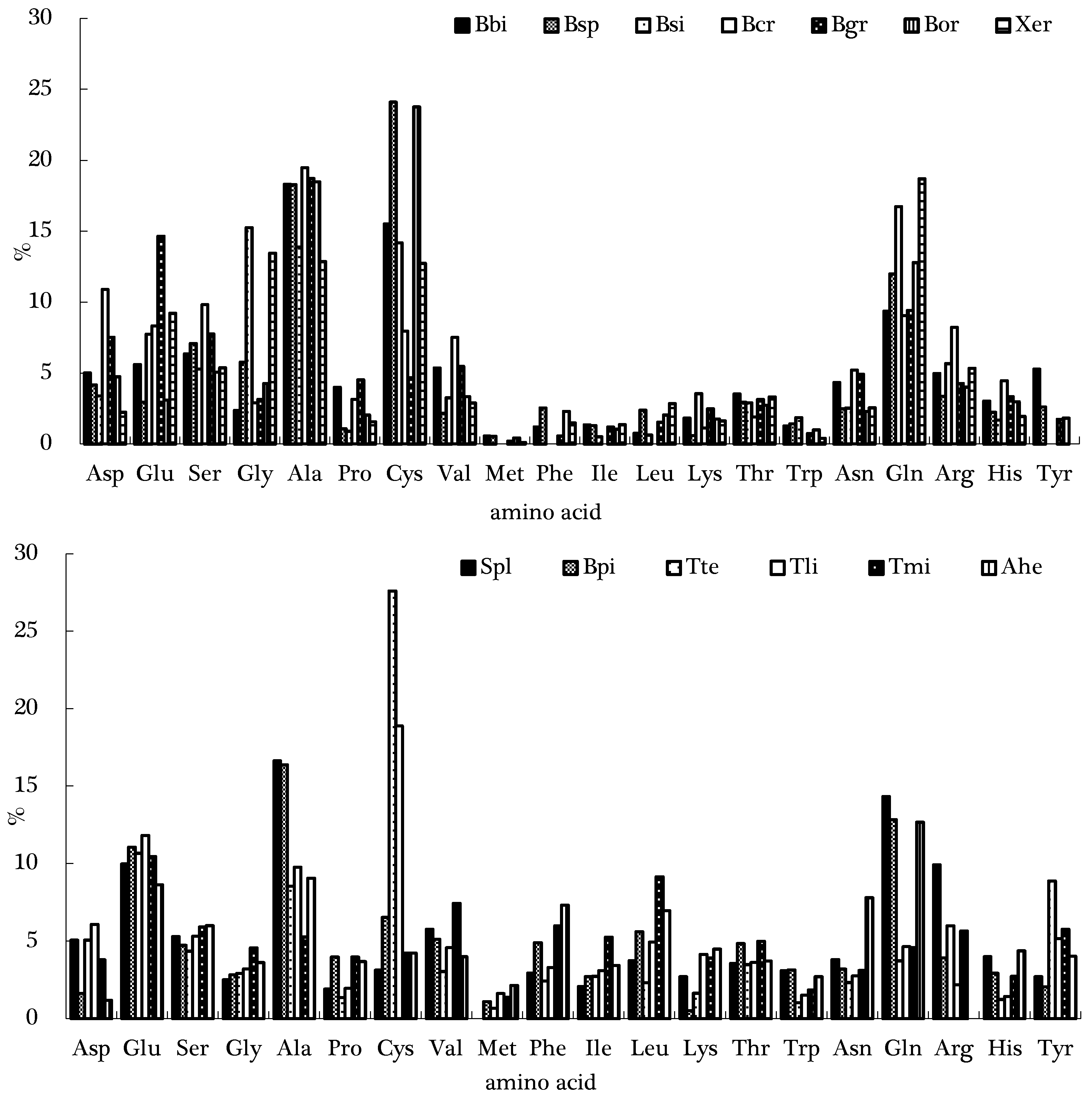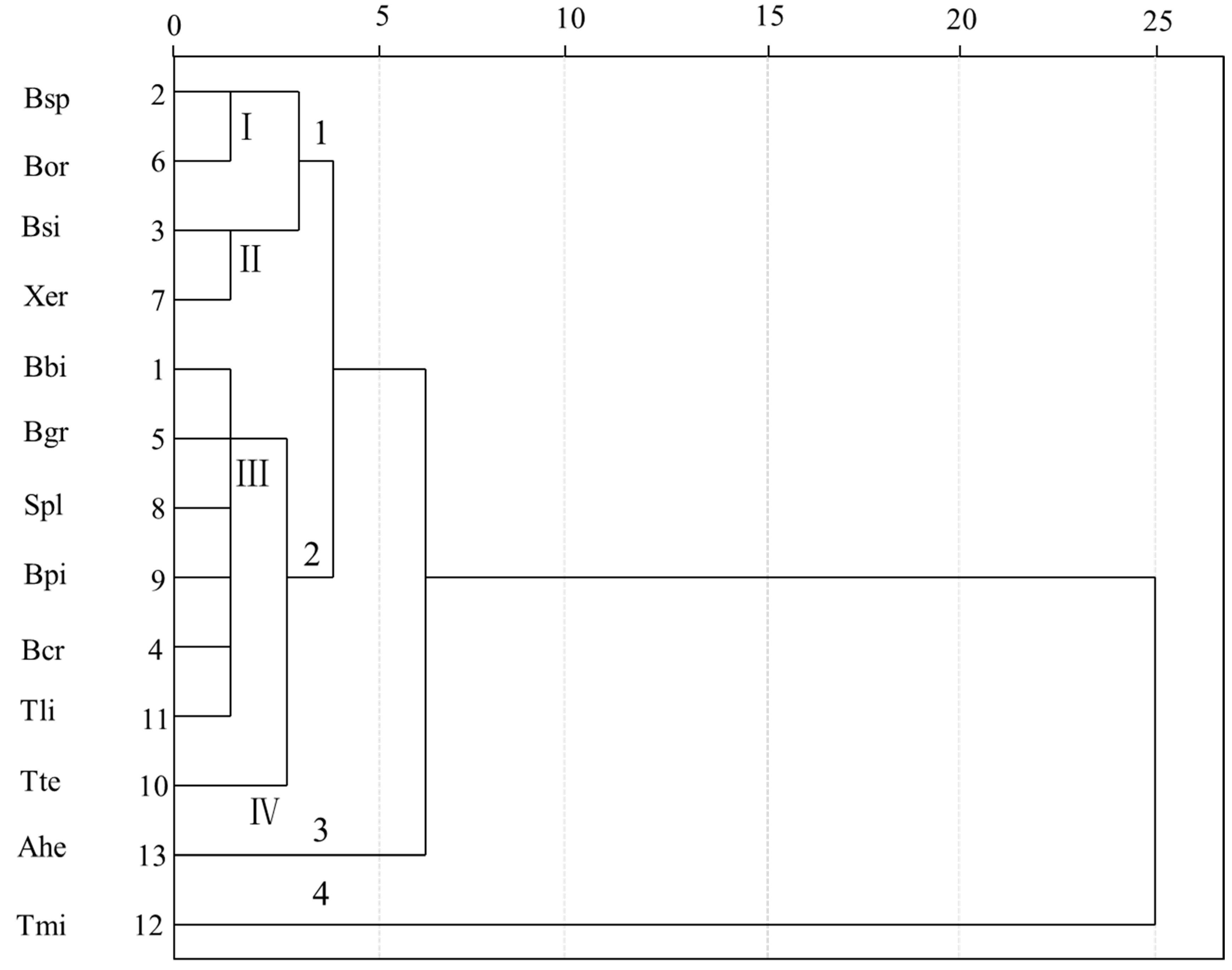Comparison of Free Total Amino Acid Compositions and Their Functional Classifications in 13 Wild Edible Mushrooms
Abstract
:1. Introduction
2. Results and Discussion
3. Materials and Methods
3.1. Sampling
3.2. Determination of Free Amino Acid Composition
3.3. Data Analysis
4. Conclusions
Acknowledgments
Author Contributions
Conflicts of Interest
References
- Friedman, M. Chemistry, nutrition, and health-promoting properties of Hericium erinaceus (Lion’s Mane) mushroom fruiting bodies and mycelia and their bioactive compounds. J. Agric. Food Chem. 2015, 63, 7108–7123. [Google Scholar] [CrossRef]
- Grosshauser, S.; Schieberle, P. Characterization of the key odorants in pan-fried white mushrooms (Agaricus bisporus L.) by means of molecular sensory science: Comparison with the raw mushroom tissue. J. Agric. Food Chem. 2013, 61, 3804–3813. [Google Scholar] [CrossRef] [PubMed]
- Wang, L.; Ma, Z.Q.; Du, F.; Wang, H.X.; Ng, T.B. Feruloyl esterase from the edible mushroom Panus giganteus: A potential dietary supplement. J. Agric. Food Chem. 2014, 62, 7822–7827. [Google Scholar] [CrossRef] [PubMed]
- Kalač, P. Chemical composition and nutritional value of European species of wild growing mushrooms: A review. Food Chem. 2009, 113, 9–16. [Google Scholar] [CrossRef]
- Rotzoll, N.; Dunkel, A.; Hofmann, T. Quantitative studies, taste reconstitution, and omission experiments on the key taste compounds in morel mushrooms (Morchella deliciosa Fr.). J. Agric. Food Chem. 2006, 54, 2705–2711. [Google Scholar] [CrossRef] [PubMed]
- Liu, Y.T.; Sun, J.; Luo, Z.Y.; Rao, S.Q.; Su, Y.J.; Xu, R.R.; Yang, Y.J. Chemical composition of five wild edible mushrooms collected from Southwest China and their antihyperglycemic and antioxidant activity. Food Chem. Toxicol. 2012, 50, 1238–1244. [Google Scholar] [CrossRef] [PubMed]
- Lin, S.L.; Lai, T.; Chen, L.; Kwok, H.; Lau, C.B.; Cheung, P.C.K. Antioxidant and antiangiogenic properties of phenolic extract from Pleurotus tuber-regium. J. Agric. Food Chem. 2014, 62, 9488–9498. [Google Scholar] [CrossRef] [PubMed]
- Özyurek, M.; Bener, M.; Guclu, K.; Apak, R. Antioxidant/antiradical properties of microwave-assisted extracts of three wild edible mushrooms. Food Chem. 2014, 157, 323–331. [Google Scholar] [CrossRef] [PubMed]
- Wu, S.R.; Luo, X.L.; Liu, B.; Gui, M.Y. Analyse and advise to research and development of wild edible fungi. Food Sci. Technol. 2010, 35, 100–103. [Google Scholar]
- Zhang, X.Y. Research on the International Market of the Wild Edible Fungus in Yunnan Province. Master’s Thesis, Yunnan University, Kunming, China, 2010. [Google Scholar]
- Zhang, J.; Li, T.; Yang, Y.L.; Liu, H.G.; Wang, Y.Z. Arsenic concentrations and associated health risks in Laccaria mushrooms from Yunnan (SW China). Biol. Trace Elem. Res. 2015, 164, 261–266. [Google Scholar] [CrossRef] [PubMed]
- Kim, M.Y.; Chung, L.M.; Lee, S.J.; Ahn, J.K.; Kim, E.H.; Kim, M.J.; Kim, S.L.; Moon, H.I.; Ro, H.M.; Kang, E.Y.; Seo, S.H.; Song, H.K. Comparison of free amino acid, carbohydrates concentrations in Korean edible and medicinal mushrooms. Food Chem. 2009, 113, 386–393. [Google Scholar] [CrossRef]
- Mau, J.L.; Lin, H.C.; Ma, J.T.; Song, S.F. Non-volatile taste components of several speciality mushrooms. Food Chem. 2001, 73, 461–466. [Google Scholar] [CrossRef]
- Leόn-Guzmán, M.F.; Silva, I.; Lόpez, M.G. Proximate chemical composition, free amino acid contents, and free fatty acid contents of some wild edible mushrooms from Querétaro, México. J. Agric. Food Chem. 1997, 45, 4329–4332. [Google Scholar] [CrossRef]
- Ribeiro, B.; Andrade, P.B.; Silva, B.M.; Baptista, P.; Seabra, R.M.; Valentão, P. Comparative study on free amino acid composition of wild edible mushroom species. J. Agric. Food Chem. 2008, 56, 10973–10979. [Google Scholar] [CrossRef] [PubMed]
- Tsai, S.Y.; Tsai, H.L.; Mau, J.L. Non-volatile taste components of Agaricus blazei, Agrocybe cylindracea and Boletus edulis. Food Chem. 2008, 107, 977–983. [Google Scholar] [CrossRef]
- Kıvrak, İ.; Kıvrak, Ş.; Harmandar, M. Free amino acid profiling in the giant puffball mushroom (Calvatia gigantea) using UPLC–MS/MS. Food Chem. 2014, 158, 88–92. [Google Scholar] [CrossRef] [PubMed]
- Tsai, S.Y.; Wu, T.P.; Huang, S.J.; Mau, J.L. Nonvolatile taste components of Agaricus bisporus harvested at different stages of maturity. Food Chem. 2007, 103, 1457–1464. [Google Scholar] [CrossRef]
- Fu, H.Y.; Shieh, D.E.; Ho, C.T. Antioxidant and free radical scavenging activities of edible mushrooms. J. Food Lipid. 2002, 9, 35–43. [Google Scholar] [CrossRef]
- Zhuang, Y.L.; Sun, L.P.; Zhao, X.; Wang, J.F.; Hou, H.; Li, B.F. Antioxidant and melanogenesis-inhibitory activities of collagen peptide from Jellyfish (Rhopilema esculentum). J. Sci. Food Agric. 2009, 89, 1722–1727. [Google Scholar] [CrossRef]
- Seow, E.K.; Ibrahim, B.; Muhammad, S.A.; Lee, L.H.; Cheng, L.H. Differentiation between house and cave edible bird’s nests by chemometric analysis of amino acid composition data. LWT-Food Sci. Technol. 2016, 65, 428–435. [Google Scholar] [CrossRef]
- Drewnowska, M.; Falandysz, J. Investigation on mineral composition and accumulation by popular edible mushroom common chanterelle (Cantharellus cibarius). Ecotoxicol. Environ. Saf. 2014, 113, 9–17. [Google Scholar] [CrossRef] [PubMed]
- Mao, X.L. Micromycetes of China; Science Press: Beijing, China, 2009. [Google Scholar]
- Yuan, M.S.; Sun, P.Q. Pictorial Book of Mushrooms of China; Sichuan Science and Technology Publisher: Chengdu, China, 2013. [Google Scholar]
- Sample Availability: Mushroom species samples are available from the authors.



| Species | Bbi | Bsp | Bsi | Bcr | Bgr | Bor | Xer | Spl | Bpi | Tte | Tli | Tmi | Ahe |
|---|---|---|---|---|---|---|---|---|---|---|---|---|---|
| Asp | 169.6 (6.9) | 186.7 (3.9) | 164.1 (0.8) | 159.3 (5.3) | 232.5 (3.9) | 200.7 (1.6) | 126.7 (2.3) | 113.1 (8.7) | 42.1 (2.7) | 182.1 (3.3) | 145.8 (8.6) | 497.3 (9.6) | 63.7 (3.8) |
| Glu | 189.7 (7.4) | 132.5 (4.0) | 374.7 (9.8) | 121.8 (4.0) | 452.8 (1.6) | 131.3 (3.0) | 520.5 (5.4) | 222.3 (14.8) | 285.6 (10.7) | 382.5 (8.8) | 283.0 (13.4) | 1369.2 (16.0) | 462.6 (10.9) |
| Ser | 215.3 (6.2) | 318.0 (5.5) | 256.0 (9.5) | 143.6 (5.5) | 239.7 (0.5) | 214.4 (3.5) | 303.7 (3.0) | 118.1 (8.8) | 122.4 (5.3) | 156.4 (4.4) | 127.7 (7.0) | 775.7 (13.4) | 322.4 (22.1) |
| Gly | 80.2 (2.6) | 259.4 (1.7) | 738.2 (30.2) | 42.3 (1.9) | 97.3 (0.5) | 180.5 (4.1) | 760.0 (4.8) | 55.9 (4.3) | 73.1 (3.4) | 104.9 (1.7) | 76.9 (3.1) | 597.9 (10.4) | 194.3 (5.7) |
| Ala | 620.1 (15.6) | 820.8 (7.9) | 672.4 (7.9) | 284.8 (9.2) | 578.4 (2.3) | 782.7 (6.3) | 727.0 (5.8) | 370.9 (27.6) | 423.0 (18.6) | 306.3 (6.0) | 233.9 (10.1) | 690.9 (10.2) | 485.4 (13.5) |
| Pro | 135.2 (6.5) | 48.1 (2.8) | 43.4 (7.0) | 46.0 (1.3) | 139.8 (7.7) | 86.7 (0.7) | 88.3 (1.5) | 42.4 (1.3) | 102.9 (2.8) | 48.8 (4.1) | 46.8 (2.7) | 521.6 (43.4) | 198.1 (20.5) |
| Cys | 525.4 (17.8) | 1082.4 (53.8) | 686.4 (3.4) | 116.2 (0.1) | 144.7 (5.8) | 1006.2 (45.7) | 719.8 (26.7) | 69.8 (4.8) | 168.9 (7.6) | 990.5 (5.7) | 452.5 (43.6) | 555.5 (36.7) | 227.2 (32.0) |
| Val | 181.3 (9.9) | 97.2 (2.0) | 157.4 (5.5) | 109.8 (5.2) | 169.0 (0.8) | 141.5 (1.4) | 163.3 (1.4) | 128.6 (8.9) | 132.4 (6.1) | 109.3 (1.7) | 109.8 (4.5) | 971.8 (18.1) | 214.4 (5.1) |
| Met | 19.1 (0.6) | 24.7 (0.1) | nd | nd | 6.2 (0.2) | 18.2 (0.9) | 6.0 (0.1) | nd | 28.2 (1.7) | 24.0 (0.0) | 38.6 (2.1) | 180.4 (7.3) | 114.7 (2.5) |
| Phe | 40.8 (2.1) | 113.9 (0.5) | nd | nd | 17.2 (0.3) | 97.3 (1.3) | 83.7 (1.7) | 65.5 (4.6) | 126.6 (5.8) | 87.0 (0.0) | 79.1 (3.4) | 785.8 (14.4) | 392.5 (13.5) |
| Ile | 45.8 (2.4) | 58.3 (1.0) | 25.0 (0.7) | nd | 36.7 (0.0) | 44.4 (0.4) | 76.8 (1.5) | 46.3 (2.9) | 70.1 (3.8) | 98.0 (2.0) | 74.3 (3.4) | 689.6 (10.2) | 184.1 (4.6) |
| Leu | 25.4 (1.5) | 106.8 (1.2) | 30.8 (0.3) | nd | 47.3 (0.4) | 86.3 (2.6) | 160.5 (4.3) | 83.4 (5.6) | 145.0 (7.2) | 83.3 (1.3) | 118.3 (7.2) | 1197.3 (6.1) | 373.0 (12.8) |
| Lys | 61.8 (2.3) | 27.0 (3.0) | 171.7 (0.3) | 16.5 (0.0) | 76.7 (2.6) | 74.4 (21.1) | 92.1 (4.6) | 60.5 (8.8) | 13.2 (3.3) | 58.8 (1.1) | 99.4 (9.7) | 512.1 (10.4) | 241.2 (14.9) |
| Thr | 119.1 (3.8) | 132.3 (2.2) | 140.5 (3.0) | 28.0 (1.1) | 97.0 (0.1) | 116.0 (2.4) | 187.2 (16.1) | 79.6 (5.7) | 125.3 (5.8) | 125.3 (3.0) | 86.9 (3.8) | 653.6 (9.1) | 199.9 (4.6) |
| Trp | 43.2 (3.1) | 63.9 (0.2) | 90.1 (8.3) | nd | 23.0 (0.7) | 42.1 (1.0) | 22.4 (0.4) | 69.1 (3.0) | 81.3 (5.6) | 37.0 (1.7) | 36.3 (2.5) | 241.9 (5.6) | 145.6 (3.0) |
| Asn | 146.4 (5.5) | 111.5 (2.0) | 122.3 (2.9) | 76.2 (3.4) | 152.0 (2.3) | 97.3 (2.1) | 143.9 (1.1) | 85.0 (5.4) | 82.7 (4.5) | 83.4 (5.4) | 66.0 (4.1) | 408.0 (8.2) | 417.7 (24.0) |
| Gln | 316.8 (10.0) | 538.2 (15.4) | 810.3 (4.8) | 132.4 (6.3) | 291.3 (0.3) | 541.4 (13.5) | 1056.5 (1.2) | 319.4 (0.2) | 331.7 (16.9) | 133.9 (2.2) | 111.2 (7.5) | 601.7 (15.3) | 679.6 (15.4) |
| Arg | 168.2 (9.1) | 151.0 (3.2) | 274.3 (10.8) | 120.4 (4.3) | 131.9 (1.1) | 170.0 (18.6) | 301.8 (9.4) | 221.0 (14.9) | 101.3 (2.9) | 215.0 (9.3) | 52.0 (3.6) | 742.0 (20.6) | nd |
| His | 102.3 (3.1) | 100.6 (0.3) | 81.6 (4.0) | 65.3 (2.7) | 103.1 (3.8) | 125.9 (2.5) | 109.9 (0.4) | 89.3 (5.8) | 75.8 (3.5) | 44.6 (1.1) | 34.1 (2.8) | 357.5 (6.6) | 234.8 (9.3) |
| Tyr | 178.4 (8.7) | 117.3 (1.2) | nd | nd | 53.8 (0.1) | 77.0 (2.5) | nd | 60.3 (6.7) | 52.9 (3.0) | 318.4 (6.2) | 124.0 (6.2) | 756.4 (20.4) | 216.6 (6.3) |
| TAA | 3384.1 | 4490.6 | 4839.2 | 1462.6 | 3090.4 | 4234.3 | 5650.1 | 2300.5 | 2584.5 | 3589.5 | 2396.6 | 13,106.2 | 5367.8 |
| EAA | 536.5 | 624.1 | 615.5 | 154.3 | 473.1 | 620.2 | 792 | 533 | 722.1 | 622.7 | 642.7 | 5232.5 | 1865.4 |
| EAA/TAA | 0.16 | 0.14 | 0.13 | 0.11 | 0.15 | 0.15 | 0.14 | 0.23 | 0.28 | 0.17 | 0.27 | 0.40 | 0.35 |
| FAA | 359.3 | 319.2 | 538.8 | 281.1 | 685.3 | 332.0 | 647.2 | 335.4 | 327.7 | 564.6 | 428.8 | 1866.5 | 526.3 |
| FAA/TAA | 0.11 | 0.07 | 0.11 | 0.19 | 0.22 | 0.08 | 0.12 | 0.15 | 0.13 | 0.16 | 0.18 | 0.14 | 0.10 |
| SAA | 1050.8 | 1446.3 | 1710.0 | 516.7 | 1055.2 | 1264.3 | 1879.0 | 587.3 | 721.4 | 616.4 | 485.3 | 2586.1 | 1200.2 |
| SAA/TAA | 0.31 | 0.32 | 0.35 | 0.35 | 0.34 | 0.30 | 0.33 | 0.26 | 0.28 | 0.17 | 0.20 | 0.20 | 0.22 |
| HAA | 1593.1 | 2352.2 | 1615.4 | 556.8 | 1139.3 | 2263.3 | 2025.4 | 806.9 | 1197.1 | 1747.2 | 1153.3 | 5592.9 | 2189.4 |
| HAA/TAA | 0.47 | 0.52 | 0.33 | 0.38 | 0.37 | 0.54 | 0.36 | 0.35 | 0.46 | 0.49 | 0.48 | 0.43 | 0.41 |
| Elements | PC1 | PC2 | PC3 | PC4 |
|---|---|---|---|---|
| Asp | 0.474 | 0.778 | −0.058 | 0.304 |
| Glu | 0.700 | 0.612 | 0.259 | −0.100 |
| Ser | 0.762 | 0.482 | 0.312 | 0.240 |
| Gly | 0.109 | 0.402 | 0.880 | 0.152 |
| Ala | 0.172 | 0.045 | 0.568 | 0.705 |
| Pro | 0.868 | 0.439 | 0.081 | 0.007 |
| Cys | −0.134 | 0.148 | 0.155 | 0.883 |
| Val | 0.767 | 0.622 | 0.111 | 0.019 |
| Met | 0.958 | 0.205 | 0.015 | 0.005 |
| Phe | 0.932 | 0.307 | 0.084 | 0.028 |
| Ile | 0.831 | 0.537 | 0.066 | 0.030 |
| Leu | 0.856 | 0.479 | 0.116 | 0.007 |
| Lys | 0.816 | 0.451 | 0.276 | −0.041 |
| Thr | 0.594 | 0.585 | 0.466 | 0.066 |
| Trp | 0.874 | 0.261 | 0.222 | −0.036 |
| Asn | 0.93 | −0.012 | 0.273 | −0.055 |
| Gln | 0.190 | −0.052 | 0.945 | 0.222 |
| Arg | 0.405 | 0.832 | 0.277 | 0.137 |
| His | 0.922 | 0.215 | 0.244 | 0.079 |
| Tyr | 0.868 | 0.445 | −0.034 | 0.093 |
| Eigenvalues | 14.16 | 2.632 | 1.262 | 0.821 |
| Variance | 70.81% | 13.16% | 6.31% | 4.12% |
| Cumulative | 70.81% | 83.97% | 90.27% | 94.39% |
| Time (min) | Flow Rate (mL/min) | Mobile Phase A (%) | Mobile Phase B (%) |
|---|---|---|---|
| 0 | 1 | 100 | 0 |
| 1.9 | 1 | 100 | 0 |
| 18.1 | 1 | 43 | 57 |
| 18.6 | 1 | 0 | 100 |
| 22.3 | 1 | 0 | 100 |
| 23.2 | 1 | 100 | 0 |
| 26 | 1 | 100 | 0 |
| 1 | Draw 2.5 μL borate buffer from vial 1 | 8 | Draw 0.5 μL FMOC from vial 4 |
| 2 | Draw 0.5 μL samples from sample vials | 9 | Mix 4 μL in air, max speed, 6 times |
| 3 | Mix 3 μL in air, max speed, 2 times | 10 | Draw 0 μL ACN from vial 6 |
| 4 | Draw 0 μL water from vial 2 | 11 | Draw 32 μL water from vial 5 |
| 5 | Draw 0.5 μL OPA from vial 3 | 12 | Mix 18 μL in air, max speed, 6 times |
| 6 | Mix 3.5 μL in air, max speed, 6 times | 13 | Inject |
| 7 | Draw 0 μL water from vial 2 |
© 2017 by the authors. Licensee MDPI, Basel, Switzerland. This article is an open access article distributed under the terms and conditions of the Creative Commons Attribution (CC BY) license ( http://creativecommons.org/licenses/by/4.0/).
Share and Cite
Sun, L.; Liu, Q.; Bao, C.; Fan, J. Comparison of Free Total Amino Acid Compositions and Their Functional Classifications in 13 Wild Edible Mushrooms. Molecules 2017, 22, 350. https://doi.org/10.3390/molecules22030350
Sun L, Liu Q, Bao C, Fan J. Comparison of Free Total Amino Acid Compositions and Their Functional Classifications in 13 Wild Edible Mushrooms. Molecules. 2017; 22(3):350. https://doi.org/10.3390/molecules22030350
Chicago/Turabian StyleSun, Liping, Qiuming Liu, Changjun Bao, and Jian Fan. 2017. "Comparison of Free Total Amino Acid Compositions and Their Functional Classifications in 13 Wild Edible Mushrooms" Molecules 22, no. 3: 350. https://doi.org/10.3390/molecules22030350





